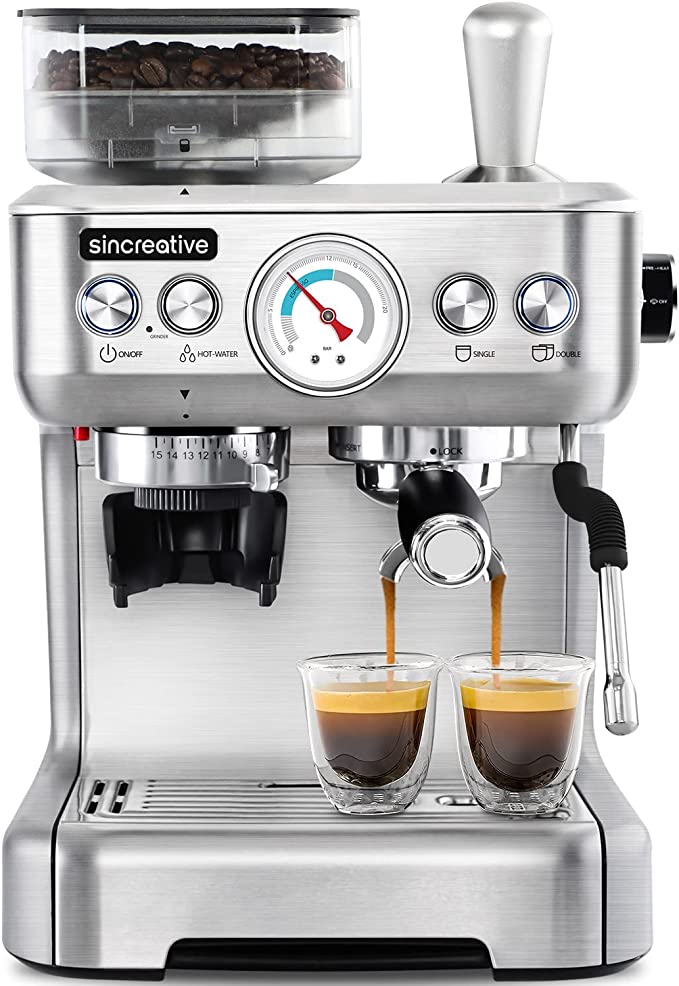MR MIRYE RZ2-EM01-US Espresso Machine: Unlock the Science of Perfect Espresso
Update on Sept. 17, 2025, 4:02 a.m.
It’s a ritual familiar to millions: the unmistakable scent of finely ground coffee, the low hum of a pump, and then, a slow, viscous stream of dark amber liquid pouring into a waiting cup. To the uninitiated, it’s just coffee. To the connoisseur, it’s a moment of pure bliss, a concentrated dose of flavor and aroma, crowned with a rich, caramel-colored crema. This isn’t magic; it’s a meticulously choreographed dance of physics and chemistry. And understanding the science behind that perfect shot is the key to unlocking its full potential, even in your own kitchen.

The Myth of the “20-Bar” Shot
For decades, the “golden rule” of espresso has been the 9-bar pressure standard. It’s the sweet spot identified by Italian engineers in the mid-20th century—the force required to push water through tightly packed coffee grounds without scorching them or leaving them under-extracted. This pressure is about nine times that of standard atmospheric pressure at sea level, and it’s the very foundation of modern espresso.
When you see a home machine advertised with a 20-bar pump, it’s easy to assume that more pressure must mean a better, more powerful shot. But this is a common misconception. Think of it like the engine of a sports car: a powerful engine doesn’t mean you’re always driving at top speed. It means you have plenty of reserve power to handle varying conditions, like a steep hill or a sudden acceleration. In the world of espresso, the “hill” is an inconsistent grind or an uneven tamp. A higher-capacity pump, like the one in the MR MIRYE RZ2-EM01-US, ensures that the machine can consistently maintain the optimal brewing pressure, even when facing these variables. This stability is the real prize, preventing pressure drops that lead to a weak, watery shot. It’s a quiet but critical safeguard for your coffee, and a testament to modern engineering.

The Unforgiving Thermometer: Why Every Degree Matters
Beyond pressure, the most critical variable in espresso is temperature. A mere few degrees can transform a shot from a delightful experience to a bitter disappointment. The ideal brewing window is narrow, between 195°F and 205°F ($90^\circ C - 96^\circ C$).
If the water is too cool, it won’t have enough energy to fully extract the flavorful oils and solids from the coffee grounds. You’ll end up with a sour, thin, and under-extracted shot that lacks body. On the other hand, if the water is too hot, it will aggressively pull out undesirable compounds, leading to a burnt, astringent, and acrid flavor. The most challenging aspect for home espresso machines is thermal stability. A machine needs to heat up quickly and, more importantly, stay hot throughout the brewing process. The 1400W heating system in the MR MIRYE RZ2-EM01-US is a prime example of this engineering principle. Its high wattage allows it to heat up the water rapidly and recover its temperature quickly after brewing, which is crucial if you’re making multiple drinks. It’s the silent hero working behind the scenes, ensuring your second shot is just as good as your first.

The Hydrodynamics of a Perfect Flow
Even with perfect pressure and temperature, a great shot can be ruined by an uneven flow of water. This is a common problem known as channeling. Imagine the compressed bed of coffee grounds, or “puck,” as a dense, complex maze. When hot water hits this maze, it naturally seeks the path of least resistance. If there are any tiny gaps, cracks, or loose spots in the puck, the water will rush through them, creating narrow channels. This leads to some parts of the coffee being over-extracted (the channels) and others being under-extracted (the rest of the puck). The result is a cup with both bitter and sour notes, a confusing and unpleasant experience.
To combat this, many modern machines, including the MR MIRYE RZ2-EM01-US, employ a technique called pre-infusion. Before the full pressure is applied, the machine gently wets the coffee puck with low-pressure water for a few seconds. This allows the grounds to expand evenly, filling in any small gaps and creating a more uniform resistance. When the high pressure finally kicks in, the water flows evenly through the entire puck, ensuring a balanced and complete extraction of all the wonderful flavors the coffee has to offer. It’s a small detail, but it’s a game-changer for the final cup.
The Milk Froth: A Lesson in Biochemistry
A great espresso machine is not complete without a steam wand. But how does a simple jet of steam turn cold milk into a creamy, velvety microfoam? The answer lies in protein denaturation. Milk contains proteins, and when you introduce hot steam, the high temperature causes these proteins to unfold and rearrange themselves. This process creates a stable molecular network that traps tiny air bubbles. The swirling motion of the steam wand helps to evenly distribute the heat and incorporate the air, creating a uniform, silky texture that’s perfect for latte art. It’s a simple, elegant display of applied biochemistry.
The Science of a Good Cup
Ultimately, a good cup of espresso isn’t an accident. It’s the result of precise, controllable variables—pressure, temperature, and flow—working in harmony. A machine like the MR MIRYE RZ2-EM01-US serves as an excellent case study in how modern engineering applies these fundamental scientific principles to create a reliable and user-friendly product. By understanding the physics and chemistry behind each step, you can move beyond simple trial and error. You can become the master of your own espresso, adjusting the grind, tamping pressure, and timing to create a shot that is not just good, but consistently perfect. So next time you brew a cup, take a moment to appreciate the science in your hands.







































